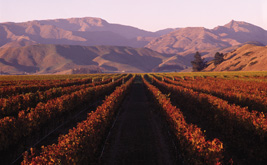There were six New Zealand producers represented at last month’s Decanter New World Fine Wine Encounter: Nautilus, Dog Point, Brancott Estate, Saint Clair, Mud House, and Mt Beautiful. The first four of these producers are based in Marlborough, and Mud House sources Marlborough grapes for its Sauvignon Blanc. Mt Beautiful was the surprise amongst the bunch, hailing from the North Canterbury region of Cheviot Hills, virtually unknown as a wine region.
I’d like to focus on the Pinot Noir coming out of Marlborough, rather than the region’s famous (or notorious, depending on your viewpoint) Sauvignon Blanc. This tasting allowed me to get a handle on what I feel are the region’s characteristics for Pinot Noir, and to develop a profile for identifying Marlborough pinot in a blind tasting. The other two notable pinot noir regions in New Zealand are Martinborough (in the North Island) and Central Otago (further south); in some cases it can be useful to compare the wines of Marlborough to these two styles.
All the wines showed here were 2009, with the exception of Dog Point (2008). Brancott had both an entry level pinot and a reserve wine (“Terraces“). Saint Clair had two single vineyard pinots (“Pioneer” and “Doctor’s Creek“).
These wines were all a bright, translucent ruby in the glass. Lighter than most Central Otago pinots; similar in hue to those of Martinborough. The aroma profiles were generally very fruit forward. Mostly red fruit, raspberry and cranberry, although some wines broached the black fruit divide and brought out notes of cherry. The more interesting examples had undertones of shrubbery and savoury notes. One of the key markers for me on the nose was a white peppery note. I get something similar in the aroma profiles of the other New Zealand pinot regions, although Marlborough has the ‘lightest spice’ of the three.
On the palate, more often than not, I would find the fruit flavours to be ‘darker’ – cherry and even blackberry – than that on the nose. This was rather curious, but quite distinctive. These wines were generally tart and lean, light bodied, with crisp acidity, and moderate to high alcohol. The better wines displayed an distinct, flinty minerality. Tannins were, in general, tight and focused. Oak aging of the wines was well-proportioned in the main; my major criticism would be the presence of unpleasant wood tannins on some of the wines. Finish length varied with the quality of the wine and the age of the vines.
Central Otago pinots, by way of contrast, seem more ‘jammy’, and with even deeper black fruit. I feel they have more of a ‘black pepper’ note rather than a ‘white pepper’. Martinborough wines, again, seem to have darker fruit, although not necessarily ‘jammy’ and accompanied by pleasant herbaceous notes. I find they have a ‘warmer’, gravelly minerality.
In summary
Where available, the single vineyard pinots, or the reserve wines, were a huge step up from the more generic entry level wines. They were more interesting aromatically, had more structure and depth of flavour. Of course, these wines come with an increased price tag.
On the whole, I felt all of these wines lacked a certain concentration found, say, in Burgundy. The exception to this trend being the wine from Dog Point. The grapes for their pinot all come from the Marlborough sub-region of the Wairau Valley. They practise low cropping and the vines are 30 years old. This vine age made a huge difference in the final wine. With an intense depth of fruit, savoury notes and light spice, this wine had a nose that went on and on. Firm, tight tannins on the palate, crisp acidity, black fruit, licorish root and a huge finish. If the alcohol had been a degree lower, I could see this wine starting to rival some of those out of Burgundy.
Nautilus Estate, from their laudable minimal intervention vineyard, receives an honourable mention. While less concentrated than Dog Point, I felt this wine was an excellent example of the Marlborough style. Tart red fruit on the nose, though serious black fruit on the palate. Crisp acidity, light body and fairly tight, prominent tannins.
The two Saint Clair single vineyard wines were certainly distinctive, well-made and interesting wines. I just felt they were eclipsed by Dog Point. The “Doctor’s Creek” wine, however, showed interesting savoury notes – almost like a meat pastry, and had an appealing vegetal character on the palate along with black fruit and pepper.
Overall, Marlborough pinot noir is starting to become a world-competing style. I like the lighter, leaner and tarter style of pinot rather than the brambly fruit hits I fear Central Otago pinots are starting to become. As the vines age, concentration will come. For me, the key for winemakers is to retain their acidity, their mineral expression of terroir, and above all, to keep alcohol levels down, preferably below 13%.
I look forward to mapping the development of these wines over the years to come.


Pingback: New Zealand highlights at the Decanter New World Fine Wine Encounter | The Oxford Wine Blog